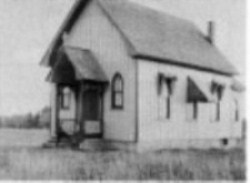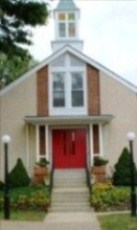History
St. John's Episcopal Church was founded in 1890 after a group of twenty families from tiny rural Glencarlyn in Arlington County petitioned the Virginia Theological Seminary to set up a mission church for them. The parents had grown concerned that there was no church close by for them and their children.
The seminary granted their request, and the church that grew up in Glencarlyn, although Episcopal, was regarded as the "Village Church," gathering in residents of Glencarlyn from all religious backgrounds. Today's St. John's still reflects that tradition and continues to gather in people of all backgrounds, although from a far wider and more cosmopolitan area.
The Early Days
 In 1890 the seminary begn sending seminarians to Glencarlyn to conduct services using the Book of Common Prayer. At first, worship was held in an old picnic pavilion in the summer and in parishioners' homes in colder weather. Services were moved to the community hall after it was completed in 1892.
In 1890 the seminary begn sending seminarians to Glencarlyn to conduct services using the Book of Common Prayer. At first, worship was held in an old picnic pavilion in the summer and in parishioners' homes in colder weather. Services were moved to the community hall after it was completed in 1892.
Determined to have their own church building, members of St. John's and residents of Glencarlyn began fundraising in April 1899. In 1901 there were only 15 registered communicants (and 25 Sunday School students) at the church, but over the next 9 years, with a growing membership and steady fundraising efforts--from plays and musicals to ice cream sales--they raised enough money to have a chapel built for $1,800 in 1910. It was located at the corner of Fourth and Lexington Streets.
The original frame chapel had a small coal furnace, kerosene lamps in brackets along the walls for lighting, seating for about 70 people, an organ, and a stained glass window above the altar. Electricity was installed in 1921 and a bell tower was built in 1922. Soon after the tower was completed, the young people of St. John's started the next fund-raising effort with the goal of building a larger place for community events. Over the next 25 years that fund sometimes grew and was sometimes depleted as it supported the church through several emergencies.
The Faith to Grow
In the 1920s and 1930s the little church thrived and hummed with church-affiliated activity. In the early 1940s, however, membership fell off and St. John's was threatened with closure. Then in 1947 the parishioners took steps for growth--including publishing a weekly pamphlet on church activities that went out to the neighborhood and taking a risk on buyiing two more lots next to the south of the original church for future building.

St. John's was holding steady again when in 1953 the seminary discontinued sending seminarians to support St. John's, once again threatening the church with closure. Within a year, however, the parishioners had managed to call a priest-in-charge, the Reverend Innis Jenkins. Another building fund was set up soon after he arrived, and in July 1955 the vestry approved the construction of a new building on the lots that had been bought in 1947. Construction started in May 1956 and the new $48,000 building, at the corner of Fifth and Lexington Streets, was dedicated in October 1957. An educational annex was built onto the new church in 1960. In 1962, the original church was dismantled and transported by the Church of the Brethern, Arlington, to Standardsville, Virginia, where it was used in the construction of a Brethern conference center.
In 1976, St. John's finally gained status as an independent parish.
A Larger Village
Today St. John's in many ways remains the Village Church for the Glencaryln community. Its grounds and building provide a place for community events. Some of its members are second or third generation Glencarlynites whoses parents and grandparents also attended St. John's. However, now the parish also gathers its people from throughout Arlington and from Alexandria, Falls Church, Annandale, Springfield, and as far away as Maryland. The community that St. John's serves has become far larger than Glencarlyn Village.
This article was developed by Faye Pritchard, with information gathered from "The Village Church," a booklet published by St. John's in 1991, and from "A Historical Sketch of St. John's," a two-page paper written by Haddasah Backus.



